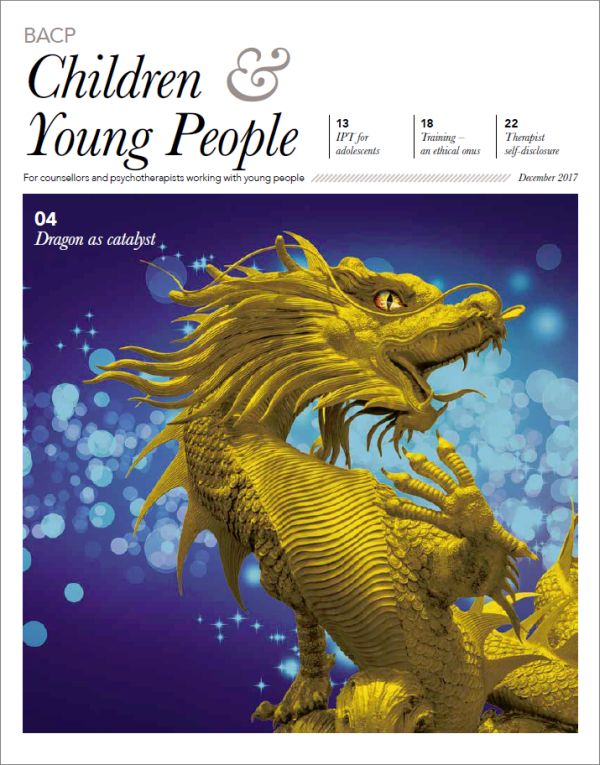In this issue
Features
Dragon as catalyst (free article)
Dennis McCarthy explains this frequently appearing, unbridled life force in play therapy
Interpersonal therapy for adolescents
Roslyn Law brings us up to date on how this approach is situated within CYP IAPT
The therapist self-disclosure dilemma
Little research exists to guide how much we tell the children, says Colleen Swinden
In practice
No man (or young person) an island
Alix Hearn discusses joined-up or co-working
Shaking the tree
The influence of home and family relationships is never absent, writes Laura McDonald
Lost in the lands of feeling
Map making to visualise and navigate emotions helps Charlie Morse-Brown’s clients
Issues
Setting up a whole-school service
Katia Houghton reports on the layers of complexity in the first year
Proper training – an ethical onus
Lisa Nel outlines what is needed, and its benefits, for safe work with young people
Living with disappointment
We all experience it – with clients, parents, supervisors and supervisees, says Nick Luxmoore.
The therapeutic relationship
Rebecca Kirkbride on the competences needed for fostering and maintaining a working alliance with 11s–18s
Regulars
Reflecting on… sugar babies
Jeanine Connor
Thinking about… the unspeakable
Alison Smyth
Considering… developmental perspectives
Nick Luxmoore

A pdf of this issue is available in the BACP Children and Young People archive
Welcome
Miles Franklin, a leading Australian author at the start of the 20th century, famously said: ‘Someone to tell it to is one of the fundamental needs of human beings.’1 Otherwise, we feel incomplete, isolated and at risk. On a daily basis, this need is often fulfilled unnoticed by family, and frequently, these days, it’s a social media ‘substitute family’ – although, according to Jan Twenge, the effects of a life spent chiefly relating (in both senses of the word) to smartphones has led today’s teens to feel lonely and anxious in unprecedented numbers.2 In the therapy world, however, it’s likely to be us receiving the most difficult stories.
For this task, especially with children and young people, we need the skill to make a relationship immediately, or the story will never emerge. We need, too, to listen to the roles played by other characters in the narrative: family, friends, teachers. Maybe inviting them into the room where appropriate. Even if they don’t physically enter, they’re surely there, having passed down to their children the expected family standards, some variation of self-esteem, a couple of genetic propensities, well-meant but perhaps mis-aimed advice, and/or some subtle ‘scratchings on the wall’.
At times, our own fundamental need as therapists is also to tell it as it is. This can be fulfilled when we discuss a case with a co-worker. But who has the luxury of a co-worker these days? I suppose all of us can – with permission and regard to boundaries – liaise with other professionals to discuss at least some of what we hear, perceive and feel while working with the client. If not, we can feel alone, as if lack of progress is our fault, as if the chaos is our incompetence, as if the issue is beyond resolving. We definitely need to get clarity in the progress of the work/client narrative – even if it shows up as being willing to ‘not know’ – so that we work ethically and responsibly. If we don’t have a co-worker at the workface, however, our supervisor is invaluable and always available: another credible view, but not so first-hand.
And what about self-disclosure in the therapeutic relationship? We examine this here, too, because gone are the days of deflecting everything with a young client. But between saying nothing (can we ever ‘say’ nothing?) and spilling all, there lurks a yawning gap – one that we often have to situate ourselves within from our ethical stance, experiential wisdom and on-the-hoof intuitions. And if the client’s self-disclosure mentions a relationship with a sugar daddy… Is anything ever simple in our world?
And so – interpersonal stuff. Relationship. How to build it, how to relate to schools, how to work with family, or just listening out for family themes and histories. I’m delighted that interpersonal psychotherapy (IPT) is being rolled out within the CYP brand of IAPT, because so many of young people’s issues involve all their relationships, and the strands of the adolescent version (IPT-A) address these issues so well. Reconnecting depressed adolescents with life and relationship, at a crucial stage in their brain development, is imperative – any suicide is one too many. Roslyn Law, who has been involved in this model for years, brings us up to date with what is happening with IPT-A – and maybe some of us who read this will go on to train in its use.
With dragons up front, and some practical map making thrown into the mix, not to mention our opinion columns, I hope you have enough reading matter for the seasonal break – if you’re lucky enough to get one. But to end where I started, Miles Franklin was also a feminist who, as an author, left a legacy from her estate to provide for two literary awards, one of which is for a novel showing Australian life in any of its phases. Excellent – but I hope our legacy in therapy country will be one of showing how life can be seriously improved by the offer of ‘someone to tell it to’. As our new branding says: counselling changes lives.
Eleanor Patrick
Editor
References
1 Franklin SMSM. Childhood at Brindabella. My first ten years. Sydney: Angus and Robertson; 1963.
2 Twenge JM. iGen. New York: Atria Books; 2017.
